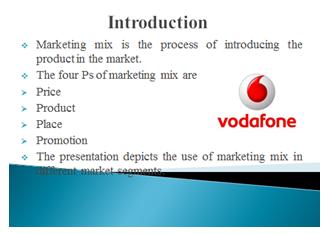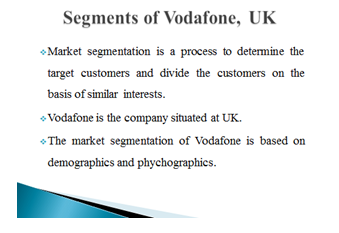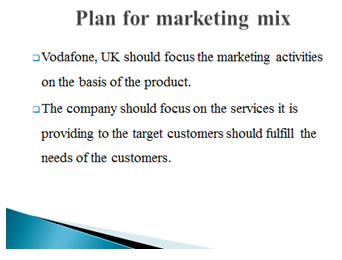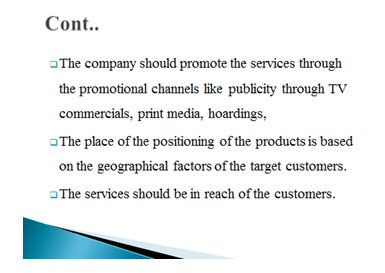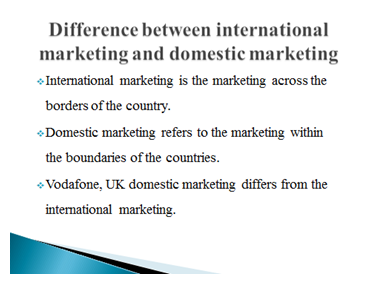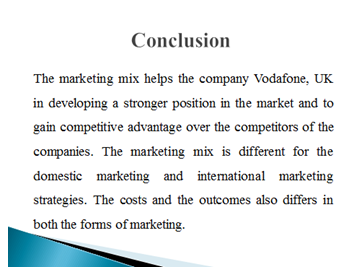- support@locusassignments.com
Unit 2 Marketing Mix Assignment

|
Program |
Diploma in Business (Marketing) |
|
Unit Number and Title |
Unit 2 Marketing Mix |
|
QFC Level |
Level 4 |
Introduction
Marketing has the pivotal role to play in the business to make it a success. Despite of the high quality of the products, the products will not be able to create a unique position in the market if the products are not marketed in a most efficient manner. Marketing is a process identifying the target customers and then setting of policies, a way to communicate with public and making the sale of products possible. The report is being prepared to explain the role of marketing and marketing process. The focus is given on the marketing mix and the benefits of product positioning, marketing segmentation, identification of target customers and pricing strategies are explained. In this marketing mix report, for the purpose of explaining the marketing principles, an organization has been chosen named as Marks & Spencer, situated at UK. The company mainly deals in the industry of retail of garments. The report includes the study of the marketing principles of the company. The report also explains the positioning strategy of the company as well as the target customers and market segmentation of the company.

Task 1 Driving a hard bargain
1.1 Explain the various elements of marketing process.
Marketing process refers to the process of identification of the target customers and opportunities for the products in the market, preparation of the marketing mix of the products, and then analyzing the efforts of the marketing need to be undertaken. The marketing process consists of various elements such as ;
- Identification of the opportunities for the product of the company in the external environment of the market. The opportunities like the demand of the product, taste, needs and preferences of the customers, etc.
- The identification of the target customers is an important element of the marketing process. As the identification of target can make the marketing focus more effective and may increase the effectiveness of the marketing policies.
- Marketing mix forms the base for presenting the product in front of the public. The marketing mix consist of four P’s, i.e. Product, in which the company focuses on the product they are offering. Price, in which the company determines the appropriate pricing policy for the product. Place, in which the company make sure the availability of the product in the market. And lastly, Promotion, in which the efforts of the company is vested in making the position of the product superior among the customers.
In an organization like Marks & Spencer, the company implements the marketing process to attract the customers towards its products. The research team keeps on finding new opportunities in the market to launch new range of clothing. Target customers are identified as the young age group and the efforts are done in indulge in manufacture of clothes concerning their demand. Marketing efforts are carried out in determining the four P’s and establishing the brand accordingly in the market (Baren, 2014).
1.2 Evaluate the benefits and costs of a marketing orientation for a selected organization.
Market orientation is a strategy that focuses mainly on the demands and needs of the customers and accordingly the products of the company are being tailored as per customers’ desire. The market orientation strategy is the customer centric process which yields higher profits for the company as it focuses on the customer satisfaction which is an important part for the growth of any business. Marks & Spencer also gives importance to the market orientation policies to gain competitive advantage in the market. Instead of involving in the “hard sell” approach of marketing, the marketing of Marks & Spencer prioritize the actual needs of the customers through a conduct of proper research study and keeping in mind the needs of the customers the manufacturing of the clothing is done rather than forcing the customers to buy the stuff by using pressure tactics. Pressurizing the customers may lead to lose the customers and the prospects demands, thus making the customers the center point for tailoring the products may results in number of benefits, such as;
- The production process can be speed up with the more focused production. The efforts and the resources of Marks & Spencer will be efficiently utilized in the production of particular type of garments which the customers actually want to buy. This increases the productivity as well as more revenue as a result of repetitive purchases.
- Focused marketing programs can be less time consuming and result orienting.
- Improved customer relationship provides the reputed position in the market to the company.
Despite of various benefits of the market orientation strategy, there are certain pitfalls also, such as;
- The investment by Marks & Spencer on the research conducted to study the needs of the customers is very high.
- Production as per the needs of the customers is sometimes not cost effective for the company (Farell, et., al., 2010).
Contact us
Get assignment help from full time dedicated experts of Locus assignments.
Call us: +44 – 7497 786 317Email: support@locusassignments.com
Order Now!!
Task 2 The next management meeting
Introduction
The company operates in an environment full of changes and challenges that the company has to face in the competitive environment. There are various factors in the business environment which affects the growth of the company and these factors include both the micro as well as macro level factors. It is important for the company to conduct a research on the environmental changes on regular time intervals to keep the company updated with the recent trends in the market. At the same time, focus should be given on the segmentation of the market on the basis of the category of the products, targeting the customers and positioning the product which is reachable to the customers for the betterment of the company.
2.1 Show macro and micro environment factors which influence marketing decisions.
The company gets affected with both types of micro and the macro environmental factors. In Marks & Spencer, the micro environmental factors consist of the customers, suppliers, competitors and public. The macro factors include economic, social and technological factors.
The impact of micro environmental factors on Marks & Spencer can be determined as;
- The customers are the important factor which cannot be neglected as they directly affects the business of the company. the needs and choice in garments has an impact on the marketing process to be undertaken.
- If the suppliers have the monopoly in a kind of textile then it can control the production of Marks & Spencer and ultimately the business.
- The policies of the competitors have the major impact on the competitive position of Marks & Spencer.
- The social responsibility of the company towards general public affects the business in a significant manner.
The impact of macro level environmental factors on Marks & Spencer can be determined as;
- The economic factors impacts the revenue generated by the company.
- The technological factors determine the effective productivity in the garments. The choice of the customers has become different and it is on the company to use the advance technology to fulfill the needs of the customers and to manufacture the garments as per the choice of the targeted young customers.
- The social factor of environment considers the steps taken by the company towards its social responsibility. Marks & Spencer always focuses on the corporate social responsibility and steps are taken to protect the environment and social interest which has a positive impact on the business of the organization (Viswanathan, et., al., 2014).
2.2 Propose segmentation criteria to be used for products in different markets.
The market segmentation is a process of division of the market on the basis of the choices, needs, and demands of the products of the company. The customers having similar interest and taste are identified and segmented for the purpose of more focused strategies. The segmentation criteria for Marks & Spencer segregate the market on the following criteria;
Demographic factors include the segmentation of the market on the basis of age, attitude, education, religion and income of the customers. The target customers of Marks & Spencer mostly are the youth between the age of 16 to 50 years males and females.
Geographical segmentation of the market concerns to the marketing on the basis of the area, country, region, state. Marks & Spencer’s business for retail garments mainly segmented in UK.
Another criteria for segmentation of the products in different market consist of benefit segmentation where the products are marketed according to the benefits that the customers are expecting from the customers (Maricic, 2015).
2.3 Choose a targeting strategy for a selected product/service.
Targeting strategy for the marketing of a product is a process of segregating the customers and selecting a set of customers and offering the products to the needs o0f the selected group of customers. The company then makes the decision regarding offering the generic product to the whole segment or to offer different products to the different segments of the targeted market. In Marks & Spencer, the company adopts the policy of targeting strategy to make the marketing efforts more concentrated towards the customers who are the most attractive set of customers for the business of the company. In target marketing include various types of strategies that can be used to categorized the segmentation of the market such as niche marketing, where the company focuses on a smaller part of the market rather than focusing on the entire segment of the market which yields the highest part of profit for the company. Another strategy is Mass marketing, where the company instead of meeting the needs of a particular segment of market, offer the same range of product to the entire market segment assuming that the need for the product is similar to all. Thirdly, differentiated marketing is a strategy in which the company offers tailored products to each segment of the selected market.
In Marks & Spencer, the differentiated marketing is adopted and the garments according to the choices of the segments of the market are manufactured to entertain the needs of the muti segmented market (Venzin, 2016).
2.4 Demonstrate how buyers’ behavior affects marketing activities in different buying situations.
The buying behavior of customers is based on the attitudes, preferences, income and attitude of the customers. The analysis of the buying behavior of the customers is important for the purpose of the focused marketing activities in order to attract the customers by satisfying the factors of the customers which constitute the behavior of buying. The marketing activities can be a success only is the demands of the customers are understood in a proper way. The buying behavior of the customers has an impact on the marketing activities of the company in different buying situations. The behavior of the buyers are influenced with their nature such as some buyers think a lot before making the buying decision which ultimately affects the marketing activities. Some of the important factors that affect the marketing activities are the income of the customers as they buy goods according to their paying capacity, their culture, age and the recent trends also influence their choices and ultimately affect the marketing activities of the company (Baidya, 2014)
2.5 Propose new positioning for as elected product/service.
The positioning strategy of the company plays a crucial role in making the image of the product they are selling on a superior position than that of the competitor’s. The product is positioned in the market considering the target audience and the focus is to attract the new buyers as well as retain the existing buyers of the product. The key factors which have to be considered in the process of positioning the product are the promotion, price, place and the product. To put the brand of the company over the competitor’s brand so that the preference of the customers can be gained is the motto of the positioning.
A new positioning for the garments of Marks & Spencer can be done with the analysis of the segment of markets where there is high demands for the range of garments offered by the company. Then, the company can promote the brand with numerous methods of advertisements including the online advertising, print media, hoardings, etc. Before advertising the product, the company must consider the target audience and accordingly the ads must be prepared in order to attract the customers. Then, the availability of the garments is the biggest issue, Marks & Spencer, should expand the location of the stores to reach to the customers in a most effective way, even it should spread the business online keeping in mind the increased craze of social media. And very importantly, the pricing policy of Marks & Spencer needs to be concentrated and research should be conducted on the price offerings of the competitors in order to place the brand superior over other clothing brands (Azad, 2013)
Conclusion
The environmental factors affect the business of the companies at micro and macro level and it is on the companies to understand these factors accordingly plan the marketing strategies. In this report, the marketing strategies adopted by Marks & Spencer regarding the segment of market and positioning of the product and brand in the market in order to promote the brand to gain competitive advantage. The report also focuses on the buying behavior of the customers and it impacts the marketing activities of the company.
Task 3 Your new role
Introduction
Marketing mix is the core element of the marketing activities of the company to make the product familiar to the public. In this report, product development and its impact on the competitive advantage is being discussed. The focus has been given on the promotional activities done by the company along placing the product, pricing and distributing the product to the customers.
3.1 Explaining how products are developed to sustain competitive advantage.
Competitive advantaged is defined as an advantage over the competitors. The companies having competitive advantage enjoy the superior revenues and more sales as compared to the direct competitors. In order to gain the sustainable competitive advantage for a longer span, Marks & Spencer, has been focusing on the product development to attract the customers. The product development is the strategy used by the companies involved in developing the product according to the needs of the customers. The product development strategy includes the development of a new product or adding new features to the existing products to make them more attractive and to gain the attraction of new customers. The uses of the product can be expanded to increase the market segment. The process involved in the product development is the selection of the idea of the generation of new product, research has been conducted for the demands of the new product, after the thorough evaluation and analysis of the market the product is launched. In this way, the product development contributes to sustain competitive advantage of the company (Festa, et., al., 2016).
3.2 Explaining how distribution is arranged to provide customer convenience.
The most important element of marketing is to effectively distribute the products in the market. Along with other factors of marketing such as advertising, pricing, promoting and positioning of the product, place is also an important element to be considered. The distribution of the product should be planned in a way that it reaches to the customers in no time and the availability of the product should not be the issue for the company. Marks & Spencer focuses on the positioning and pricing of the garments and at the same time the company has its stores at the prominent locations where the reach of the customers are easy and the channel for distribution should also be selected accordingly. The distribution of the products depends on the geographical factors and the areas where the demand is high. The distribution should be arranged in such a manner that the customers should not have to face the situation of unavailability of the product and at the same time the product should be made available at the stores before it is advertised of promoted. The distribution strategy is part of the marketing mix and comes under the heading place in the four Ps (Syhyda, 2014)
3.3 Explaining how prices are set to reflect an organization’s objectives and market conditions.
The pricing policies of the company are based on the objectives of the organization. The prices of the products are determined keeping in mind the value of the product and the cost that is implemented for the manufacture of the product. The costs incurred of the promotional activities are also included in the prices of the products. There are various types of the pricing policies which can be practiced depending on the needs of the organizations. Marks & Spencer adopts the penetration pricing policy where the company offers the products on fewer prices than the competitors. There are certain factors which are considered in the pricing strategy, the target customers, cost of production, position of the company in the market, profit expected etc. In this way the pricing policies reflect the organizational objectives and the market conditions (Dolgui & Proth, 2010)
3.4 Explaining how promotional activity is integrated to achieve marketing objectives.
Promotional activities are the part of the marketing mix and are one of the four Ps of the marketing mix. The promotional activity refers to the process of communication between the company and the customers in order to introduce the customers to the products and influence the sales of the products. The marketing objectives are meant to meet the sales and to attract the customers. There are several promotional activities which are used to promote the products as well as the brand of the company. Some of the promotional activities are advertising, where the products are advertised through online or print media or TV commercials, personal selling, where the products are sold with face to face communication with customers and the skills of salesman is required, point of purchase display is the strategy used by Marks & Spencer, where the company place the products in the showrooms at display.
3.5 Analyzing the additional elements of the extended marketing mix.
Marketing mix is the marketing strategy which involves four Ps of marketing that is the place, product, promotion and price of the product. These elements determine the success of the brand in the market and are helpful to gain the competitive advantage in the market. The mixture of these elements specifies the policies regarding the price of the product, the promotional activities involved in the advertising through various channels of the product, place which locates the product in the most attractive way so that the customers are attracted towards the project, and product development where the company indulge in the development of the product for making the position of the company superior to that of the competitors. Launching a whole new range of products to gather larger market segment or adding new features in the existing products to gain the attraction of the existing users. Apart from these four Ps, there is extended marketing mix which has been introduced in Marks & Spencer for making the marketing of the products more successful and results in more sales. The extended marketing mix includes people, concerns with the staff of the company including the people working in the sales department or the production department. The staff must be trained in order to make the marketing process a success. Another P is for physical evidence which focuses on presentation of the products before the customers in an attractive manner. Lastly, Process is another element which is the after sale services provided by Marks & Spencer to hold customer satisfaction (Fourie, 2012)
Conclusion
The report presented the study on Marks & Spencer and the marketing mix policies used by the company. The company uses the penetrating pricing policy and the place the garments in the stores at display at the prominent market places. The promotional activities which are undertaken by the company includes the online selling of clothes, personal selling as well as point of purchase policy of marketing.
Task 4 The job interview
Conclusion
The marketing forms a base for the company to introduce the products to the public and generates the sales. The market position of the business is highly dependent on the ways the company uses the strategies to market its products. The marketing strategies are developed in the company at the top management keeping in mind the customers targeted for the products of the company. In this report, an organization named Marks &Spencer has been chosen and the marketing principles have been explained considering the organization. The marketing mix as well as the extended marketing mix consisting 7 Ps have been discussed in the report. The marketing principles are discussed focusing on the micro as well as macro level analysis of the environment. The importance of the market segmentation, product development and positioning of the product has been explained in the report.
References
Azad, N., Abbasi, N. & Zarifi, S.F. 2013, "A study to determine influential factors on product positioning", Management Science Letters, vol. 3, no. 8, pp. 2229-2234.
Baidya, M. & Ghosh, G. 2014, "An empirical investigation of repeat buying behavior of customers of two brands in India", Journal of Indian Business Research, vol. 6, no. 3, pp. 255-268.
Baran, M. 2014, "Marketing", Travel Weekly, vol. 73, no. 43, pp. T8.
Dolgui, A. & Proth, J. 2010, "Pricing strategies and models", Annual Reviews in Control, vol. 34, no. 1, pp. 101-110.
Ferrell, O.C., Gonzalez-Padron, T.L., G. Tomas M. Hult & Maignan, I. 2010, "From Market Orientation to Stakeholder Orientation", Journal of Public Policy & Marketing, vol. 29, no. 1, pp. 93-96.
Festa, G., Cuomo, M.T., Metallo, G. & Festa, A. 2016, "The (r)evolution of wine marketing mix: From the 4Ps to the 4Es", Journal of Business Research, vol. 69, no. 5, pp. 1550-1555.
Fourie, I. & Ball, L. 2012, "Promotional strategies for information products and services", Library Hi Tech, vol. 30, no. 4, pp. 683-692.
Maricic, B. & Djordjevic, A. 2015, "Strategic market segmentation", Marketing, vol. 46, no. 4, pp. 243-251.
Syhyda, L.O. 2014, "Selection of marketing channels for the distribution of industrial enterprises’ innovative products", Marketing ì Menedžment Innovacìj, vol. 5, no. 1, pp. 192-200.
Tania von der Heidt & Quazi, A. 2013, "Enhancing learning-centeredness in marketing principles curriculum", Australasian Marketing Journal, vol. 21, no. 4, pp. 250.
Venzin, M. 2016, "Strategies for Marketing to Your Target Audience", Nonprofit Communications Report, vol. 14, no. 7, pp. 8-8.
Viswanathan, M., Jung, K., Venugopal, S., Minefee, I. & Jung, I.W. 2014, "Subsistence and Sustainability: From Micro-Level Behavioral Insights to Macro-Level Implications on Consumption, Conservation, and the Environment", Journal of Macromarketing, vol. 34, no. 1, pp. 8-27.
Details
Other Assignments
Related Solution
Other Solution

